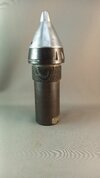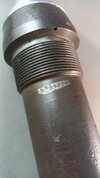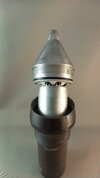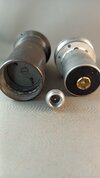British Ordnance Collectors Network
You are using an out of date browser. It may not display this or other websites correctly.
You should upgrade or use an alternative browser.
You should upgrade or use an alternative browser.
British L 5 Fuze
- Thread starter Burney Davis
- Start date
Hi Barney,
Don't think this is for the 3.5" Rocket Launcher round. So far as I am aware all were HEAT hollow cone and therefore required a base fuze. A point fuze would destroy the jet and make it ineffective.
As well as the penetrating jet, the 3.5 RL round had a copper slug that was supposed to be inserted into the tank through the hole burnt by the jet, thus really spoiling the day for the crew.
Here is an example of the slug picked up by me on the ranges after firing, it was VERY hot.
Alan1.![DSCN0863[1].JPG DSCN0863[1].JPG](https://www.bocn.co.uk/data/attachments/168/168368-b209f95ed52c53d5ca95eb139a484fd2.jpg)
Don't think this is for the 3.5" Rocket Launcher round. So far as I am aware all were HEAT hollow cone and therefore required a base fuze. A point fuze would destroy the jet and make it ineffective.
As well as the penetrating jet, the 3.5 RL round had a copper slug that was supposed to be inserted into the tank through the hole burnt by the jet, thus really spoiling the day for the crew.
Here is an example of the slug picked up by me on the ranges after firing, it was VERY hot.
Alan1.
![DSCN0863[1].JPG DSCN0863[1].JPG](https://www.bocn.co.uk/data/attachments/168/168368-b209f95ed52c53d5ca95eb139a484fd2.jpg)
Found this on Bocn : https://www.bocn.co.uk/threads/pro-design-fuze.104579/#post-322271
Eggburt1969
Well-Known Member
I thought I would show this rather unusual Fuze. Normally fitted to 3.5" Rocket HE shells for anti-tank use as I understand.
Does anyone have a sectioned diagram they could post?
The Fuze Percussion L5 is, as far as I'm aware, a copy of one of the US M404 models. Possibly the M404A1, as the UK text I have says M404 'Mark 1', which doesn't exist, but the M404A1 does. The M404 series were used with the US developed 3.5" M20 'HEAT' (aka shaped charge) and M30 busting WP smoke rockets for the M20 series 'Super Bazooka'.
Yes, I concur, as mentioned above, that the L5 were for a 3.5" rocket. Obviously, just like the US 'M' (standard Model) code system, there are a multitude of 'L5' things, and likely other fuzes.Hi Barney,
Don't think this is for the 3.5" Rocket Launcher round. So far as I am aware all were HEAT hollow cone and therefore required a base fuze. A point fuze would destroy the jet and make it ineffective.
As well as the penetrating jet, the 3.5 RL round had a copper slug that was supposed to be inserted into the tank through the hole burnt by the jet, thus really spoiling the day for the crew.
Here is an example of the slug picked up by me on the ranges after firing, it was VERY hot.
Alan1.
A nose-mounted fuze would cause loss of penetration capability for a shaped charge (aka HEAT) equipped munition, but it would not "destroy the jet". Anything at in front jet is simply penetrated, the jet tip eroding slightly as it passes through.
As to shaped charge "burning holes" in the structures hit is a very, very common misconception. The physical mechanism by which the jet penetrates the structure hit has nothing really to do with heat (temperature). The primary penetrating mechanism is pressure.
The velocity of the jet tip is commonly in the 7-12 km/s (approx. 23,000-39,000 ft/s, approx. 16,000-27,000 mph) velocity range. The velocity of the jet is not constant, the tip is far higher than the rear, as such it stretches. With older shaped charge designs, about 30% of the shaped charge liner goes into the stretching jet, whilst 70% goes into the slug at the rear, which is far slower; commonly 100s of m/s.
Due to this very high velocity, the pressure exerted on the material struck by the jet tip exceeds, by at least an order of magnitude (aka 10 times), the material's strength. The pressure experienced can be calculated using Bernoulli's principles, but it's essentially the faster and denser the material (fluid), the higher the pressure.
Due to the pressure exerted by the jet tip being over ten times the strength of the material, the material it is simply pushed out of the way. No "burning" takes place, though things do get rather hot as they are rapidly moved around.
The pressure experienced by material the jet is made of is also way above its strength and as such it is also pushed out of the way as penetration occurs. In general as the target material is pushed out of the way to form a crater, the eroded jet material coats the outside of the crater. In reality, some target and jet material flows backwards towards the incoming jet, which can cause problems.
Penetration continues until the pressure exerted by the jet is less than that required to deform the target material. Hence when the velocity drops below a level that results in a pressure that is less than target material's plastic deformation strength.
At this point, what's left of the jet and slug are present in the bottom area of the hole the jet created.
However if the target is thinner than the amount of target material the jet can penetrate, this results in the jet, bits of the target, high pressure and temperature detonation product gases, and sometimes the slug, all passing into the target. The jet and slug tend to have a straight line flight path, whilst the spalled off target material forms a cone of lethal high velocity fragments.
If the jet, slug, or target spall fragments hits a person, or energetic materials (propellant, high explosive fillings, etc.), the result is commonly catastrophic.
Last edited:
Thank you for that Gentlemen.
I know little of post WW2 fuzes but as I spotted a small 'L 5' on the body I assumed, obviously incorrectly, that was indicative of it's type. The reason I thought this would be a rocket fuze is that there is a resemblance to the number 711 and the profile bears no resemblance to the N97. Also, I thought the VT fuzes had to have a type of plastic on their front nose whereas this is aluminium. I think it's more likely to be a resistor condenser time fuze as MINENAZ16 suggests.
Additional pictures below may confirm the actual ID.
I know little of post WW2 fuzes but as I spotted a small 'L 5' on the body I assumed, obviously incorrectly, that was indicative of it's type. The reason I thought this would be a rocket fuze is that there is a resemblance to the number 711 and the profile bears no resemblance to the N97. Also, I thought the VT fuzes had to have a type of plastic on their front nose whereas this is aluminium. I think it's more likely to be a resistor condenser time fuze as MINENAZ16 suggests.
Additional pictures below may confirm the actual ID.
Attachments
Not sure how many holes in armour plate Eggburt1969 has actually seen, but all those that I examined showed significant signs of much heat including solidified drops of molten steel etc, and Pam 9 puts it succinctly, viz, "penetration is achieved by the impact of a high velocity jet on the armour, this jet of burning gases and molten metal is projected into the tank and, besides causing casualties to the crew, may set fire to the fuel and ammunition". Quite so. And I am glad that I did not have to teach infantrymen about Bernoulli's principles.
But Eggburt1969 is quite right that the hole in the armour is not burned through as such; equally he has missed the point that I was making that the fuze in question was not for the 3.5" rocket, and if such a fuze, by its construction and bulk, were somehow to be attached to the front, ie in the metal nose that provides the stand off required for the rocket's warhead, it would so degrade the jet as to render it ineffective in penetrating the tank armour of the day.
And I am glad that Barney has at least a partial identification of his fuze, like him I know little of post-war developments, fascinating though that field is.
Alan1
But Eggburt1969 is quite right that the hole in the armour is not burned through as such; equally he has missed the point that I was making that the fuze in question was not for the 3.5" rocket, and if such a fuze, by its construction and bulk, were somehow to be attached to the front, ie in the metal nose that provides the stand off required for the rocket's warhead, it would so degrade the jet as to render it ineffective in penetrating the tank armour of the day.
And I am glad that Barney has at least a partial identification of his fuze, like him I know little of post-war developments, fascinating though that field is.
Alan1
Eggburt1969
Well-Known Member
I worked for considerable time as a contractor to the UK MoD on a military testing (proof and experimental) range doing the instrumentation, radiography and high speed photography on weapon trials. So yes, I've seen a lot of holes made in things, which have been made by many different types of weapon, these often employing shaped charge warheads.Not sure how many holes in armour plate Eggburt1969 has actually seen, but all those that I examined showed significant signs of much heat including solidified drops of molten steel etc, and Pam 9 puts it succinctly, viz, "penetration is achieved by the impact of a high velocity jet on the armour, this jet of burning gases and molten metal is projected into the tank and, besides causing casualties to the crew, may set fire to the fuel and ammunition". Quite so. And I am glad that I did not have to teach infantrymen about Bernoulli's principles.
But Eggburt1969 is quite right that the hole in the armour is not burned through as such; equally he has missed the point that I was making that the fuze in question was not for the 3.5" rocket, and if such a fuze, by its construction and bulk, were somehow to be attached to the front, ie in the metal nose that provides the stand off required for the rocket's warhead, it would so degrade the jet as to render it ineffective in penetrating the tank armour of the day.
And I am glad that Barney has at least a partial identification of his fuze, like him I know little of post-war developments, fascinating though that field is.
Alan1
I'm sorry to say the statement from PAM 3 is utter trash. Many basic military manuals and other similar sources quote the same rubbish. Most likely as trying to explain (even basically) how shaped charges work is hard. As such it is simply easier to quote the simplistic statement, which is regurgitated in PAM 3. As can be seen be reading my 'very' basic overview of how shaped charges work, it's quite technical, and probably not for consumption by your average squaddie.
For note, when a shaped charge's copper liner is detonatively-collapsed, the surface temperature of the jet formed is around 500-600C. So well below its melting point of 1085C. You do get further heating when the jet interacts with the steel, but heat is not part of the penetration process, it's pressure due to the very high speeds involved.
As to the behind armour effects (BAD). Some small particles of the jet and armour may be heated to a level that burn in air. But again, it's the speed not the heat that is the primary 'initial' damaging factor. Also, things don't need to be all that hot to set off propellants, or more volatile fuels (petrol). Diesel fuel tanks attacked with a shaped charges have very little incendiary effect after being penetrated. In fact such diesel fuel tanks are used as low-density armour against shaped charges. As to an HE filling, generally they are shock-initiated by high speed impact of the jet, or spall. Many can be brought to detonation through the deflagration to detonation process. This either by direct heating and then ignition by a fragment that has reached the HE filling, or by the cook-off effect, i.e. fast or slow external heating.
Yes, I was aware to what you were saying, this being that such a massive fuze is not suitable for use with shaped charge based weapons. For note though, many early projectile and rocket munitions, which used the shaped charge effect had quite massive fuzes, though nothing like the one seen above. The US MK 149 and MK 188 series used with the 5.0” Zuni rocket HEAT warheads are both quite long, respectively 4.22” and 5.159”. So a lot of material to pass through, which is not idea.
As to the effect of the fuze on the performance of the shaped charge. It all depends on how the fuze is constructed and what it's constructed from. A massive (mostly solid) steel and/or copper alloy fuze will certainly degrade the jet's performance. One that is steel or copper alloy, but will lots of spaces in it will degrade the jet to a lesser extent. An aluminium alloy fuze, due to its lower density, will degrade the jet at about 1/3 of that of one made of steel or copper alloy. Penetration of the jet, once material strengths are exceeded, is more of less a difference in density thing.
Oh dear.
I had suspected that my comment would generate a further page from Eggburt1969, and I was not wrong, but he describes the performance section of Pam 9 - NOT Pam 3 - as utter trash, which is a bit unfair on the writers of said pamphlet. Whilst perhaps not precisely scientifically accurate, what is written is a fair summation of what happens.
And so, notwithstanding his reference to the average squaddie, I challenge Eggburt1969 to do better.
If he will, in 20 words or less (to replace the wording in the Section that so offends him) provide me, either by PM or via this medium if the Moderator, whose query started the whole thing in the first place, will allow, a description that is scientifically accurate, fully comprehensive and comprehensible to the average Infantry soldier - of which I was one - I shall be infinitely obliged to him and I undertake to print out that wording and to retain it within the pages of my copy of Pam 9 for possible future reference.
Alan1.
I had suspected that my comment would generate a further page from Eggburt1969, and I was not wrong, but he describes the performance section of Pam 9 - NOT Pam 3 - as utter trash, which is a bit unfair on the writers of said pamphlet. Whilst perhaps not precisely scientifically accurate, what is written is a fair summation of what happens.
And so, notwithstanding his reference to the average squaddie, I challenge Eggburt1969 to do better.
If he will, in 20 words or less (to replace the wording in the Section that so offends him) provide me, either by PM or via this medium if the Moderator, whose query started the whole thing in the first place, will allow, a description that is scientifically accurate, fully comprehensive and comprehensible to the average Infantry soldier - of which I was one - I shall be infinitely obliged to him and I undertake to print out that wording and to retain it within the pages of my copy of Pam 9 for possible future reference.
Alan1.
I'm sure these exchanges are in good humour so please lets not allow what is a very interesting thread to reach a point where deletion is required.




